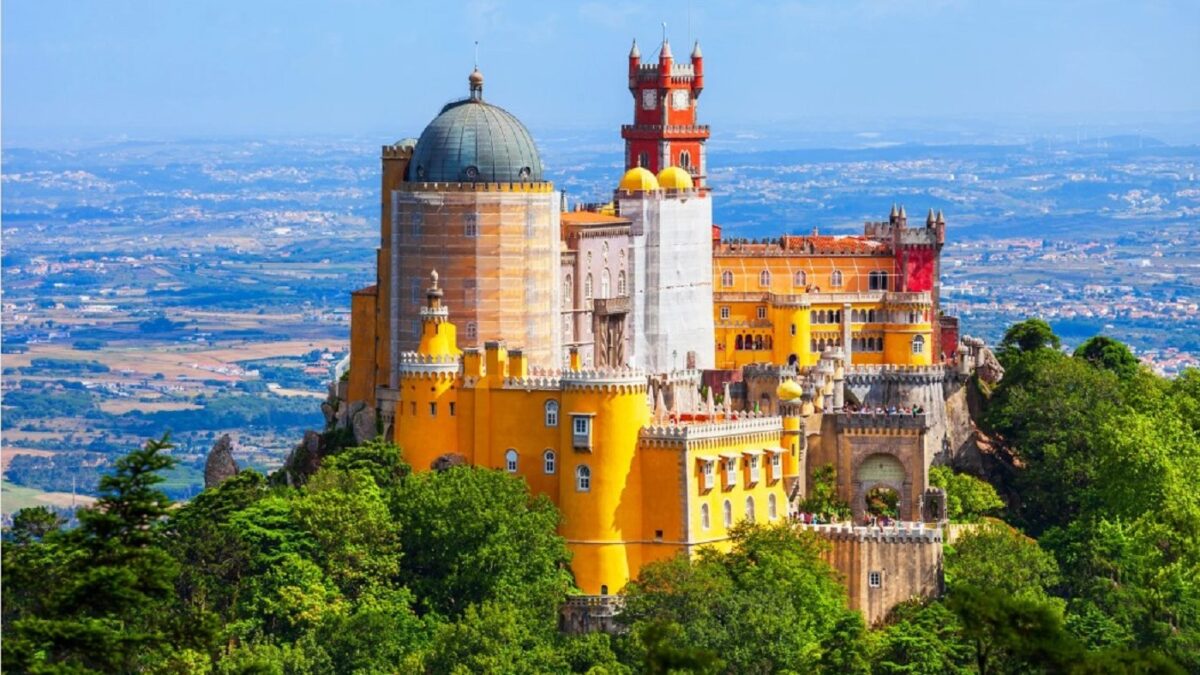Sintra Portugal: A Complete Travel Guide 2024
Introduction Sintra
Sintra, Portugal, a UNESCO World Heritage site, blends history, culture, and natural beauty. The mysterious forests, luxurious castles, and artistic masterpieces of Portugal, such as the Moorish Castle and Pena Palace, give a unique look into the country’s past and present. It was entered as a UNESCO World Heritage Site due to the Romantic buildings that were built there in the 1800s. This guide will show you the most beautiful parts of Sintra in 2024, from the grand castles to the lovely gardens.

Rich History
Portugal’s Sintra Mountains return to prehistoric times. It was called “Mons Lunae” by the Romans. The Moors built the Castle of the Moors. After the Christian Reconquista, the Portuguese elite loved it because it was cool and had lots of trees. King Ferdinand II turned a broken-down church into the Pena Palace in the 1800s, now drawing people worldwide.
Best Time to Visit
Many people visit Sintra, Portugal, annually because of its exciting feel and significant buildings. Spring and fall are the best times to visit for excellent and beautiful scenery because of the pleasant weather and stunning natural wonders. It’s warm and busy in the summer, but it can be expensive and crowded. Winter is a quiet time between December and February with few people around. Sintra is a beautiful place because of its natural beauty and massive castles.
How to Get Sintra
People who live in or visit Sintra, Portugal, can get there. You can get there by car, train, bus, or trip. Rossio Station in Lisbon is where many trains that run every 40 minutes stop. If you take the IC19 highway, you can see Sintra and the places around it in 30 minutes. Because of the traffic, buses could be better, but Scotturb goes to many places in Lisbon. Tours can help you see Pena Palace, Moorish Castle, and Quinta da Regaleira.
To avoid lines, buy a ticket that lets you go both ways. Check the bus and train times, and remember that storage space will be limited during peak tourist seasons.
Best Attraction Place in Sintra

Pena Palace
The Pena Mountains are where they are. King Ferdinand II of Portugal mixed traditional Portuguese ways of life with Moorish, Gothic, and Manueline building styles when he constructed it. The front of the castle is made of bright terracotta, yellow, and blue stones. It stands out against all the green in the park.
Inside the castle are tiles that look like they were made in the Moorish style, stonework that is very complicated, fancy furniture from the time, stuccoes that are very complicated, and wood work that is very complicated. It’s nice to look out at the fields and the Atlantic Ocean from the Queen’s Terrace. The Arab Room has a Moorish style. Peña Park is a big forest area that goes well with the castle. There are secret paths that people can find.
Moorish Castle
The Moorish Castle, also called Castelo dos Mouros, shows how the Iberian Peninsula looked during the time of the Muslims. This is an old spot in Sintra, Portugal. At the top of Mount Sintra, you can see the town and the Atlantic Ocean very well. Between 800 and 900, Moors from North Africa built the castle to protect the area from the Crusades.
Its rough and helpful design has walls with turrets, watchtowers, and original Moorish living rooms. People can look at the Archaeological Museum, the middle courtyard, and the walls that have been fixed up.
Quinta da Regaleira
The Gothic, Manueline, and Renaissance styles of architecture make Quinta da Regaleira a famous place for tourists to visit in Sintra, Portugal. The estate has a church, a palace, and a beautiful park with lakes, caves, wells, benches, and fountains. The house has a fancy Gothic front with lots of carvings and stonework.
The most exciting thing about the park is the Initiation Well, which is an upside-down tower used for Tarot initiation ceremonies. There are also links between Quinta da Regaleira and alchemy, Masonry, the Knights Templar, and the Rosicrucians. They give us a unique look into Portugal’s mysterious past.
National House of Sintra
The National House of Sintra is an old house with two cone-shaped chimneys in Sintra, Portugal. Updating and adding to its unique mix of Gothic, Manueline, Moorish, and Mudéjar types has been ongoing since the 8th century. The Swan Room, the Magpie Room, and the Arab Room are some of the beautifully decorated rooms in the house.
It was named a UNESCO World Heritage Site in 1910 and is known as a summer retreat for the Portuguese elite. People can look around the historic rooms and enjoy the collection of traditional Portuguese tiles. The views and landscapes around the palace make it an unforgettable experience.
Dom Lvaro de Castro
Dom Lvaro de Castro founded the historical convent in Portugal, the Convent of the Capuchos, also known as the Convento dos Capuchos or the Cork Convent, in 1560. It is designed to be a place of peace and simplicity for Franciscan monks, so it fits in perfectly with the natural surroundings. Crafted from local materials like stone and wood, the convent’s simple design reflects the Franciscan ideal of living and being closely connected with nature.
According to the ascetic monks, the small living spaces and rooms lined with cork show this. In modern times, the Convent of the Capuchos is a museum anyone can visit. It shows how the Franciscan monks lived a simple life, representing minimalism and caring for the environment.
Palace of Monserrate in Sintra
People know the Palace of Monserrate in Sintra, Portugal, as a secret gem because it combines Gothic, Indian, Moorish, and Manueline styles. The palace contains detailed stucco work, carved arches, and decorative columns. James Thomas Knowles designed it. Formerly a chapel dedicated to Our Lady of Monserrate, the spot became famous thanks to Gerard de Visme and Lord Byron.
Within the palace’s botanical gardens are peaceful paths and water features that circle various native and exotic plants. The grounds and palace have been thoroughly restored to protect their beauty and historical value.
Seteais Palace
Seteais Palace, a neoclassical palace in Sintra, Portugal, is renowned for its historical grandeur and architectural elegance. It was constructed in 1787 for Daniel Gildemeester, the Dutch consul. It has ornate ceilings, paintings, and stucco work with many small details. Prince Regent John VI visited the house in the early 1800s, and the famous triumphal arch reminds us of that.
Tivoli Hotels & Resorts now operates a high-end hotel in the former Seteais Palace. It gives guests a unique look into the life of the Portuguese elite. People often hold weddings and other events at the palace, and it also has guided tours that let you see its beautiful rooms and learn about its long past.
Where to Stay in Sintra
Classic Portuguese, modern, and international restaurants are in Sintra, a beautiful town. Many people choose Tascantiga, Incomum by Luís Santos, Lawrence’s Hotel Restaurant, Cantinho Gourmet, Arola, Café Saudade, and Romaria de Baco as their favorite restaurants. At Incomum by Luís Santos, you can get creative food and excellent service, and at Tascantiga, you can enjoy snacks and traditional Portuguese food in a cozy space. Lawrence’s Hotel Restaurant is the oldest hotel on the Iberian Peninsula.
It serves fancy Portuguese and international meals made with local products. The food at Arola, which Chef Sergi Arola owns, is a unique mix of Portuguese and Spanish flavors. The food at Cantinho Gourmet is hearty Portuguese comfort food. Café Saudade is an excellent place to get small meals.
Sintra Local Culinary Delight
There are places to stay in Sintra for all tastes and budgets. The most beautiful places to stay are the Penha Longa Resort, Casa das Campainhas, Moon Hill Hostel, and Hotel Nova Sintra, which are close to the train station. The Tivoli Palácio de Seteais is a luxurious hotel with a palace from the 18th century. The Boutique Hotel, on the other hand, is more modern and comfortable.
Chalet Saudade is sweet because of its beautiful rooms and cozy café. Individual rooms and dorms are available at Moon Hill Hostel for those on a budget. Casa das Campainhas, on the other hand, combines traditional Portuguese buildings with modern luxury. The Penha Longa Resort in Sintra-Cascais Natural Park offers high-end services and outdoor activities.

